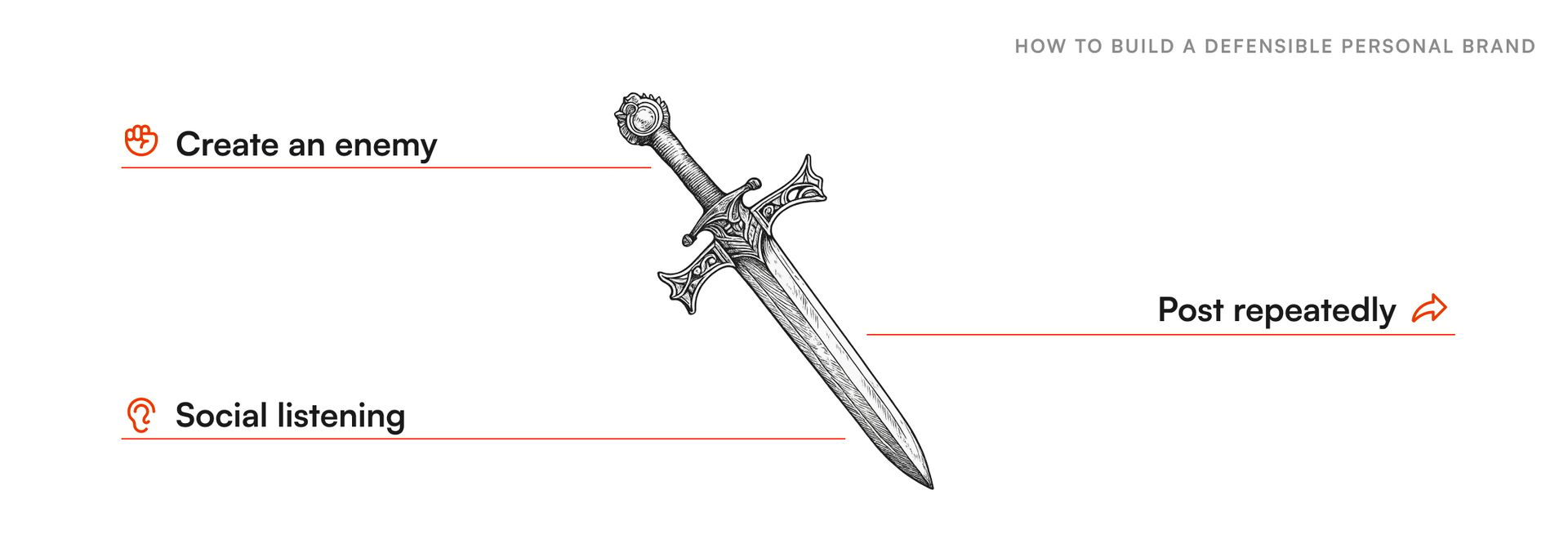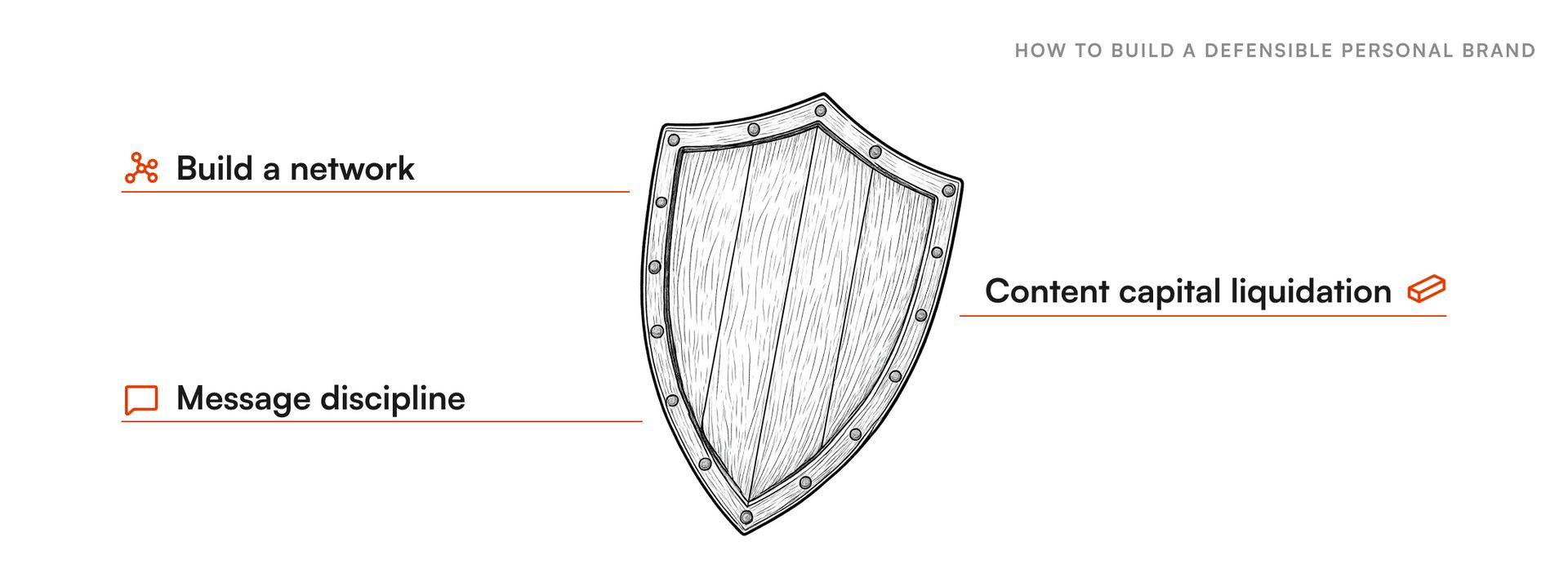It’s a Wednesday in late July. I’m interviewing a creator who speaks about “how to build a defensible personal brand.” It’s the following Monday. A creator publishes an essay about another creator plagiarizing her work the previous year.
It’s a Friday in early August. You’re reading this issue:
🎵 TikTok devalued ideas in favor of distribution
⚔ How to build a defensible personal brand through offense
🛡 How to build a defensible personal brand through defense
— Francis Zierer, Editor

Content from and about former Creator Spotlight guests.
How one quiz captured 30,000 leads in 12 months (Creator Spotlight)
Listen to our conversation with Milly Tamati on Apple Podcasts, Spotify, or wherever you tune in to your podcasts.
Can people make stuff on YouTube still? (Garbage Day)
8 Instagram reels you should steal (for local newsletters) (Life of Scoop)

Plagiarism post-TikTok
In 2020, there were 200,000 full-time equivalent creators. In 2024, there were 1.5 million. The number of original ideas did not increase at the same rate; more people are echoing fewer ideas.
Mimicry, remixing, and plagiarism are all features of the creator economy. They are not bugs. Platforms make commodities of most ideas — speed and distribution comprise the delta.
Anger, disappointment, and a plagiarism scandal on Substack. In late July, a creator named Katie Jgln published an essay reflecting on a moment one year earlier when she’d discovered a creator named Maalvika had plagiarized a previous essay. This new essay, written in part because Maalvika had been surging on the platform’s leaderboard, went semi-viral.
The event has been fertile ground for discourse about the nature of platforms and the spectrum from inspiration to plagiarism.
“Success in this new economy depends largely on having the right take and presenting it to the right audiences — which is where plagiarism enters the picture.”
The week before Katie Jgln published her essay, I interviewed Milly Tamati for this week’s podcast episode. We spoke about the idea of a “defensible personal brand,” a lens through which I considered this scandal — that in the creator economy, especially on social platforms, a personal brand is more defensible than a given idea.
There is a stark difference between the creator economy post-pandemic and pre-pandemic, and it’s all about TikTok.
TikTok did not invent plagiarism, but it established copying as a feature and at scale more than any platform before it. It perfected the practice of memetic creation. Naturally, I’m not the only person to point this out; I’ll cede this observation to Griffin Blue Emerson, who wrote a long, insightful piece inspired by the scandal:
“Tiktok exists culturally as a vehicle for more “approachable” plagiarism: after all, it began as Musically which was pitched as a vertical-video app for users to lip sync to songs, in a way pretending that it’s themselves who are singing. […]
According to Tiktok rules, maalvika did nothing wrong by copying and pasting Katie Jgln lin’s post and there’s no reason to think that she simply didn’t understand that the “rules” on Substack were different.”
The post-TikTok creator economy is defined by repetition, by volume. The more content becomes a commodity, the more creators become a commodity, the more the key measure of success is not the quality of an idea, but the effectiveness of its distribution.
Intellectual property rules are a mixed bag loosely enforced across social media platforms. The more reliable way to protect your output in the creator economy is with a well-drilled, network-backed personal brand.

How to build a defensible personal brand
Plagiarism and its siblings are a fact of life on social platforms. There’s no new idea under the sun. There are new contexts; fresh eyes open every day. There are also ways to mitigate damage, like building a defensible personal brand.
We’ll define a personal brand as the character your online activities have imprinted in the minds of other internet users. It’s how somebody who subscribes to your newsletter or YouTube channel, where you use your real name or face, would describe you to their friends.
What do you defend your personal brand against? There are only two categories of damage it can take.
Plagiarism and other forms of uncredited intellectual property usage. See Katherine Dee’s “taxonomy of borrowed ideas.”
Simply being forgotten. When you stop showing up online, the people in your audience who spent time with your content rarely spend less time on the internet consuming content because you stopped. Somebody else’s content immediately steps in.
A well-defended personal brand also has an offensive strategy.
Offense — growing and expanding the brand

1. Create an enemy
There’s no offensive play without an opponent.
Writer and strategist Nick Susi wrote an essay last year titled “if you want to create a monocultural event, start a war.” The Drake-Kendrick beef of 2024 proves his point; people like to rally around one party against another.
The more specific the enemy, the more effective a foil for the personal brand you’re trying to build.
In Milly’s case, the enemy is a difficult job market. It’s professional confusion; it’s not knowing where your career goes next. Her generalist community is an answer, an antidote, a stance against this uncertainty.
TL;DR: To stand for something, you must also stand against something.
2. Social listening
Monitor social channels for people talking about or engaging with ideas and topics core to your personal brand. Show up in the comments. Engage in earnest while referencing past content you’ve published on the same topic. Link to it where possible. Join communities related to your niche. Engage!
Done cynically, this can backfire; nobody really owns an idea on the internet. Done in good faith, it builds your network.
Revisit our May interview with Jazmin Griffith, a social listening professional, for more.
TL;DR: If there’s a conversation happening you think you should be part of, speak up.
3. Post repeatedly
This is so core a tenet of success in the creator economy that it almost doesn’t bear mentioning. But consistent volume is a nonnegotiable in building a defensible personal brand; you don’t run a marathon without days and months of training.
We’re all just building sandcastles on these social platforms, and every day, every hour brings a tide of new content to wash ours away. Every post reinforces the structure.
TL;DR: Post today. Post tomorrow. Post ad-infinitum.
Defense — protecting and reinforcing the brand

1. Build a network
The internet itself exists because the U.S. military sought to make its data centers more defensible. Networks are defensible and regenerative.
In Milly’s case, she is the leader of a community with a total cross-platform audience of over 50,000. Her LinkedIn profile alone has over 22,000 followers; a personal brand exists only in the minds of an audience; that’s a strong personal brand.
This is about establishing your position in the spectrum of influence.
TL;DR: Every business is a relationships business.
2. Message discipline
Clarify your ideas in simple language. Repeat them constantly. Every post, every podcast appearance — any time you show up and anywhere — should point back to those clarified ideas. Milly is a natural at this.
Every one of her LinkedIn posts for the past week mentions generalists. Many posts end with a sort of signature:
“👋 Hey, I'm Milly! I (over)share what working and what I'm learning as I build the generalist workforce to 1M professionals (from a lil island in the Scottish highlands). Follow along! Generalist World 🌀”
If you can’t say it in one clear sentence, you’re overcomplicating it.
Message discipline is part of constant posting. One without the other does not work; they are two legs of the same beast. Express fewer ideas; repeat them more often.
TL;DR: Pick a line, stick to it, and constantly remind everyone about it.
3. Content capital liquidation
A personal brand exists in the minds of an audience, however mediated. Platforms are stable to a point, but as I’ve covered before, nobody on any platform truly owns their audience, or rather, their relationship to their audience. The only way to own the relationship with your audience en masse is an email list .CSV file.
Any email service provider (ESP) allows you to export your subscriber list whenever you like. If you use email as a creator, you should be doing this once a week and backing it up in multiple places — in your digital drive, in your external hard drive. Consolidate and de-risk.
Use platforms. But diversify — mitigate against platform dependency.
TL;DR: On platforms, your audience is not your own. Have an email list and export it frequently.

You wouldn’t download a car
Post long enough to a large enough audience, and your work will be copied without credit. Maybe you’ll catch wind, ask the culprit to take down their post, and move on. Maybe you’ll never know.
The post-TikTok creator prioritizes distribution, volume, and the formation of a defensible personal brand. Your ideas will get stolen! It’s far more difficult to steal an entire personal brand established over months and years of posting.
One reason ideas and references so rarely get credited in the creator economy is that attention is a premium; who has the time to sit through the credits? Even at the movie theater, except in the rare cases where I’m genuinely blown away, I’m stood up as soon as the credits begin to roll. Are you still here?




